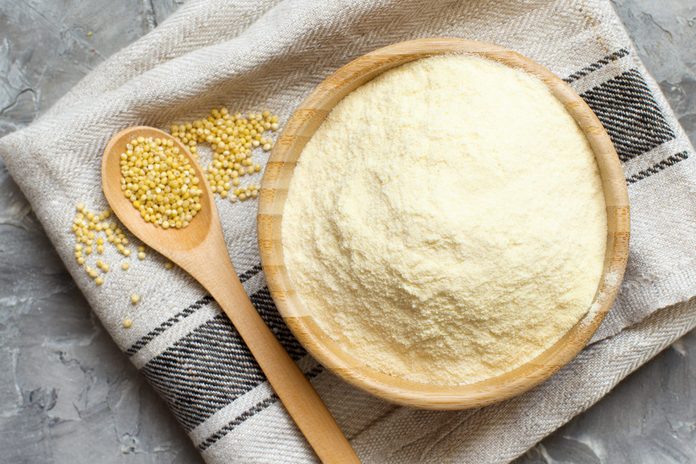Is Millet Flour Healthy? Here’s What a Nutritionist Says

Registered dietitian and plant-based diet specialist Cynthia Sass, shares why millet flour is good for you and the planet, and how to add it to nutrient-rich gluten-free dishes.
For decades all-purpose flour was the automatic go-to in the baking aisle. But these days, a wide variety of flours are available, even at mainstream supermarkets. These include options made from gluten-free whole grains—such as quinoa and brown rice—to grain-free choices like almond, coconut, chickpea, sweet potato, and cassava flours.
Whole Foods Market listed “flour power” as one of the top trends for 2020, citing consumer desire for more protein, fibre, and superfoods. Dietary restrictions, including gluten-free, and an increase in plant-based eating, have also fueled flour diversity.
One of the newer kids on the block in the baking section is millet flour, made from grinding the gluten-free ancient whole grain. Millet is less known in Canada but remains the sixth most popular cereal grain in the world.
(Related: What Is Millet? Nutrition Facts, Benefits, and How to Eat It)
Millet is good for the planet
Through funding from the Berkeley Food Institute, The Millet Project is attempting to diversify agriculture and American diets by cultivating millet in Northern California. The group notes that millet can grow with little water compared to most other grains, and is well suited to drought-like conditions.
Millet is also pest resistant, according to a study published in 2017 in the journal Frontiers in Plant Science. These attributes make millet eco-friendly, something that’s important to a growing number of consumers. According to a 2019 report from the International Food Information Council, over half of consumers say it’s at least somewhat important that the products they buy are produced in an environmentally sustainable way.
Nutrition of millet flour
Millet flour is also nutritious. Most notably, 100 grams provides 22 percent of the Daily Value (DV) for iron and energy-supporting B vitamins. The whole grain also provides antioxidants and other minerals, including magnesium, manganese, phosphorus, copper, zinc, and potassium.
Here’s some information on millet flour nutrition per 100 grams (g):
- Calories: 382
- Fat: 4.3 g (6 percent DV)
- Sodium: 4 mg (0 percent DV)
- Carbohydrates: 75 g (27 percent DV)
- Dietary fibre: 4 g (12 percent DV)
- Protein: 11 g (22 percent DV)
- Calcium: 14 mg (1 percent DV)
- Iron: 3.9 mg (22 percent DV)
- Potassium: 224 mg (5 percent DV)
(Related: How to Make Chickpea Flour and Use It in Everyday Cooking)
Potential health benefits of millet flour
The touted health benefits of millet mostly derive from its properties as a whole grain rather than millet itself. For example, because it’s a member of the whole grain family, it may offer certain benefits linked to whole grain consumption. And because it contains fibre, it may have benefits linked to fibre consumption. So, although millet isn’t directly linked to health benefits like lower cholesterol or blood pressure, it may offer some of those benefits because of the nutrients in the grain.
Note: This really depends on how often you eat it. Millet flour is likely to be consumed less often than millet grain.
However, there is one study worth highlighting that directly focuses on the consumption of millet and its benefits.
Promotes gut-friendly bacteria
A study, published in 2016 in the Journal of Scientific & Innovative Research, highlights millet’s health benefits. The grain shows prebiotic activity, which helps promote the growth of friendly gut bacteria linked to healthy digestion. And animal research, cited in the study, suggests that natural compounds in millet may protect against heart disease, cancer, diabetes, inflammation, and aging.
Gluten-free option
For people with celiac disease, gluten intolerance, or those who want to reduce gluten intake—gluten is a protein found in wheat, rye, and barley—millet flour serves as a great gluten-free alternative. Millet flour can be used to make bread, flatbreads, pilafs, and more.
This can provide much relief for those with celiac disease who can’t digest gluten because of the damage it causes to the small intestine. This can lead to symptoms like diarrhea, bloating, and abdominal discomfort. Similarly, those with a gluten intolerance will experience abdominal pain and discomfort after eating gluten.
How to use millet
Millet flour has a subtle, slightly sweet flavour. It can be used in a variety of ways as a 1:1 substitute for all-purpose flour, although it’s typically combined with other flours, like rice or sorghum. You can incorporate millet flour into pancakes, bread, and a variety of baked goods—from muffins to cookies, brownies, and cakes. It also works well in savory recipes, like pizza crust and veggie fritters, to any recipe that calls for traditional flour, like plant-based casseroles and stew.
I personally like Bob’s Red Mill millet flour ($5 per 23-ounce bag). Both brands provide recipes on their websites. And, of course, you’ll find plenty more that call for millet flour online. If you or someone in your household is gluten-free, this healthful flour may just become a new staple in your kitchen cupboard.




